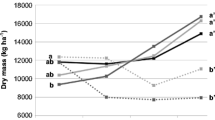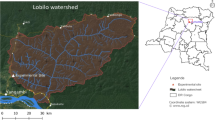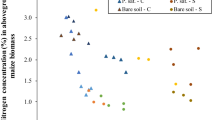Abstract
An experiment was conducted at Msekera Research Station from 1998 to 2002 to determine effect of planted fallows of tree species mixed with herbaceous legumes and those of single species fallows on biomass production, soil properties and subsequent maize grain yields. After 2 years of fallow the highest total above ground biomass of 9.2 t ha−1 was recorded in sole Gliricidia. Pre-season soil total inorganic N in 0–20 cm soil depth under tree fallows was highest in Sesbania + Macrotyloma axillare mixture. Sesbania + M. axillare mixture had the highest cumulative water intake at fallow clearing. Among the 7 mixtures and 3 sole species treatments, Sesbania + M. axillare mixture produced the highest maize yield of 2.7 and 1.9 t ha−1 in 2001 and 2002 season, respectively, after 2 years of fallow. The results of the study indicate the complementarity of herbaceous legumes and tree mixtures in improving soil quality. We conclude that mixed species have the potential to increase the amount and quantity of total N added to the soil and increase nutrient cycling. However, maize grain yields were not significantly improved as compared with single species due to low biomass production of the trees. The coiling nature and the added labour requirements for weed control would limit the use of these mixtures by smallholder farmers who are labour constrained. Agroforestry trees and non-twining legumes could be promoted instead.

Similar content being viewed by others
References
Anderson JM, Ingram JSI (1993) Tropical soil biology and fertility: a handbook of methods, 2nd edn. CAB International, Wallingford
Angus JF, Bolger TP, Kirkegaard JA, Peoples MB (2006) Nitrogen mineralisation in relation to previous crops and pastures. Aust J Soil Res 44:355–365
Bah AR, Rahman ZA (2001) Gliricidia (Gliricidia sepium) Green manures as a potential source for maize production in the tropics. In: Optimizing nitrogen management in food and energy production and environmental protection: Proceedings of the 2nd International Nitrogen Conference on Science and Policy. The Scientific World 1
Belcher DJ, Cuykendall TR, Sack HS (1950) The measurement of soil moisture and density by neutron and gamma-ray scattering. Tech. Dev. Rep. 127. Civ. Aeronaut. Admin., Washington, DC
Bouwer H (1986) Intake rate: cylinder infiltrometer. In: Klute A (ed) Methods of soil analysis, part 1, Physical and mineralogical methods—agronomy monograph number, vol 9. American Society Agronomy, Madison, pp 825–844
Brussaard L, deRuiter PC, Broan GG (2007) Soil biodiversity for agricultural sustainability. Agric Ecosyst Environ 121:233–244
Buresh RJ, Sanchez PA, Calhoun FG (eds) (1997). Replenishing soil fertility in Africa SSSA Special Publication no 51: Soil Science Society of America, Madison, WI, USA. Proceedings of an International Symposium
Chirwa TS, Mafongoya PL, Mbewe DNM, Chishala BH (2000) Changes in soil properties and their effects on maize productivity following Sesbania and Pigeonpea Improved Fallow System in eastern Zambia. M.Sc. thesis, University of Zambia
Commissaris ALTM (1975) Detailed Soil Survey of Msekera Research Station. Soil Survey report no. 19
Conyers M, Newton P, Condon J, Poil G, Mele P, Ash G (2012) Three long-term trials end with a quasi-equilibrium between C, N and pH and implication for C sequestration. Soil Res 50:527–535
Dasaeger J, Rao MR (2000) Parasitic nematode populations in natural fallows and improved cover crops, and their effects on subsequent crops in Kenya. Field Crops Res 65:41–56
Dorich RA, Nelson DW (1984) Evaluation of manual cadmium reduction methods for determination of nitrate in potassium chloride extracts of soil. Soil Sci Soc Am J 48:72–75
Dubeux JC Jr, Muir JP, Nair PR, Sollenberger LE, Silva HM, de Mello AC (2015) The advantages and challenges of integrating tree legumes into pastoral systems. In: Proceedings of the 1st international conference on forages in warm climates, Lavras, Brazil, pp 141–164
FAO-UNESCO (1998) Soil Map of the World (Revised Legend), Rome
Gathumbi SM (2000) Nitrogen sourcing by fast-growing legumes in pure and mixed species fallows in western Kenya. Ph.D thesis, Wye College, University of London, Wye, Kent, UK
Genstat 5 Committee (1988) Genstat 5 reference manual. Oxford University Press, Oxford
Gladwin C (1992) Gender impacts of fertilizer subsidy removal program in Malawi and Cameroon. Agric Econ 7:141–153
Ikerra S, Maghembe J, Smithson P, Buresh R (1999) Soil nitrogen dynamics and relationships with maize yields in gliricidia–maize intercrop in Malawi. Plant Soil 211:155–164
Jama B, Buresh RJ, Place FM (1998) Sesbania tree fallows on phosphorus-deficient sites: maize yield and financial benefit. Agron J 90:717–726
Kostiakov AN (1932) On the dynamics of the coefficient of water-percolation in soils and on the necessity for studying it from a dynamic point of view for purposes of amelioration. In: Trans. Sixth International. Society of Soil Science, Russian Part A, pp 17–21
Kwesiga F, Coe R (1994) Effect of short rotation Sesbania sesban planted fallows on maize yield. For Ecol Manag 64:199–208
Kwesiga F, Phiri D, Simwanza CP, Mwanza S (1994) Zambia/ICRAF Agroforestry Research Project annual Report. Afrena Report no. 87
Kwesiga F, Franzel S, Place F, Phiri D, Simwanza CP (1999) Sesbania sesban improved fallows: their inception, development and farmer enthuasm. Agrofor Syst 47:49–66
Lal R (1985) Mechanized tillage systems effects on properties of a tropical Alfisol in watersheds cropped to maize. Soil Tillage Res 6:149–161
Lal R (1989) Agroforestry systems and soil surface management of a tropical alfisol: V. Water infiltrability, trasmissivity and soil water sorptivity. Agrofor Syst 8:217–238
Lal R, Wilson GF, Okigbo BN (1978) No-tillage farming after various grasses and leguminous cover crops in tropical Alfisols. I. Crop performance. Field Crops Res 1:71–84
Lal R, Wilson GF, Okigbo BN (1979) Changes in properties of an Alfisol produced by various crop covers. Soil Sci 127:377–382
Mafongoya PL, Katanga R, Mkonda A, Chirwa TS, Chintu R, Matibini J (2000) Zambia/ICRAF Agroforestry Research Project, 2000 Annual Report
Maroko JB, Buresh RJ, Smithson PC (1998) Soil nitrogen availability as affected by fallow-maize systems on two soils in Kenya. Biol Fertil Soils 26:229–234
McCarty LB, Hubbard LR, Quisenberry V (2016) Applied soil physical properties, drainage, and irrigation strategies. Springer International Publishing, Cham, pp 1–72. doi:10.1007/978-3-319-24226-2_1
Mekonnen K, Buresh RJ, Jama B (1997) Root and inorganic nitrogen distributions in sesbania fallow, natural fallow and maize fields. Plant Soil 188:319–327
Murphy BW, Crawford MH, Duncan DA, McKenzie DC, Koen TB (2013) The use of visual soil assessment schemes to evaluate surface structure in a soil monitoring program. Soil Use Manag 127:3–12
Pereira HC, Wood RA, Brozostowski HW, Hosegood PA (1958) Water conservation by fallowing in semi-arid tropical East Africa. Emp J Exp Agric 26:203–228
Philips JR (1957) The theory of infiltration: the infiltration equation and its solution. Soil Sci 83:345–357
Rowell DL (1994) Soil science, methods and application. Longman Group UK Limited, Harlow
Sheoran V, Sheoran AS, Poonia P (2010) Soil reclamation of abandoned mine land by revegetation : a review. Int J Soil Sediment Water 3(2):1–21
Sileshi G, Mafongoya PL (2002) Incidence of Mesoplatys ochroptera Stal (Coleoptera: Chrysomelidae) on Sesbania sesban in pure and mixed species fallows in eastern Zambia. Agrofor Syst 56:225–231
Sileshi G, Maghembe JA, Rao MR, Ogol CKPO, Sithanantham S (2000) Insects feeding on Sesbania species in natural stands and agroforestry systems in southern Malawi. Agrofor Syst 49:41–52
Torquebiau EF, Kwesiga F (1996) Root development in Sesbania sesban fallow-maize system in eastern Zambia. Agrofor Syst 34:193–211
Wilkinson GE (1975) Effect of grass fallow rotations on the infiltration of water into a savanna zone soil of northern Nigeria. Trop Agric 52:97–103
Acknowledgments
We thank the Swedish International Development Agency (SIDA) and the Government Republic of Zambia (GRZ) for their financial support to this research. We are grateful to Messers K. Linyunga, S. Chikale, and P. Phiri for field data collection, laboratory analysis and data analysis respectively. Dr. G. Sileshi is also acknowledged for his useful comments.
Author information
Authors and Affiliations
Corresponding author
Rights and permissions
About this article
Cite this article
Mafongoya, P.L., Jiri, O. Soil nitrogen and physical properties and maize yields after mixed planted fallows of tree and herbaceous legumes. Nutr Cycl Agroecosyst 105, 75–84 (2016). https://doi.org/10.1007/s10705-016-9776-z
Received:
Accepted:
Published:
Issue Date:
DOI: https://doi.org/10.1007/s10705-016-9776-z




